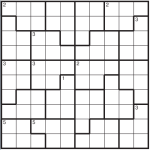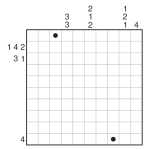I haven’t posted in a while. There are a bunch of reasons for this, including travel and a bad reaction to my first vaccine dose.
Anyway, today’s post is a tribute to Maki Kaji, who passed away last week from cancer. I was going to elaborate on my thoughts more, but honestly this post by Thomas pretty much says exactly what I wanted to, perhaps in a better way.
I got into Nikoli.com pretty late, and just had a year of solving before the online solving portion had to close. I do purchase their books from time to time and I absolutely love the giants series.
Like Thomas, my note of thanks will be for his broader contribution to the puzzle community via Nikoli, influencing me and so many other puzzlers positively.
As a tribute, I have written 3 Nikoli style puzzles, and by that I mean ‘Nikoli style’ – I’ve tried to keep look, difficulty and dimensions as I remember them from Nikoli.com.
Rules:
Akari:
- Place light bulbs (circles) according to the following rules.
- Light bulbs may be placed in any of the white squares, the number in the square shows how many light bulbs are next to it, vertically and horizontally.
- Each light bulb illuminates from bulb to black square or outer frame in its row and column.
- Every white square must be illuminated and a light bulb can not illuminate another light bulb.
Shakashaka:
- Place black “triangles in squares” (see 2) in the grid under the following rules.
- There are four kinds of black triangles you can put in the squares (shown below)
. You cannot place black triangles in the black squares. - The parts of the grid that remain white (uncovered by black triangles) always form a rectangle or a square.
- The numbers indicate how many black triangles are around it, vertically and horizontally.

Heyawake:
- A rectangle, bordered by bold lines, is called a “room”. Fill in cells under the following rules.
- The numbers indicate how many painted cells there are in a room. Rooms with no number may have any number of painted cells.
- White cells cannot stretch across more than two rooms in a straight line.
- Painted cells cannot be connected horizontally or vertically. White cells must not be separated by painted cells.
Rule credits: https://www.nikoli.co.jp/en/puzzles/index.html
Penpa links
P517: https://git.io/J0aKg
P518: https://git.io/J0aP0
P519: https://git.io/J0a1f

P517 
P518 
P519






































